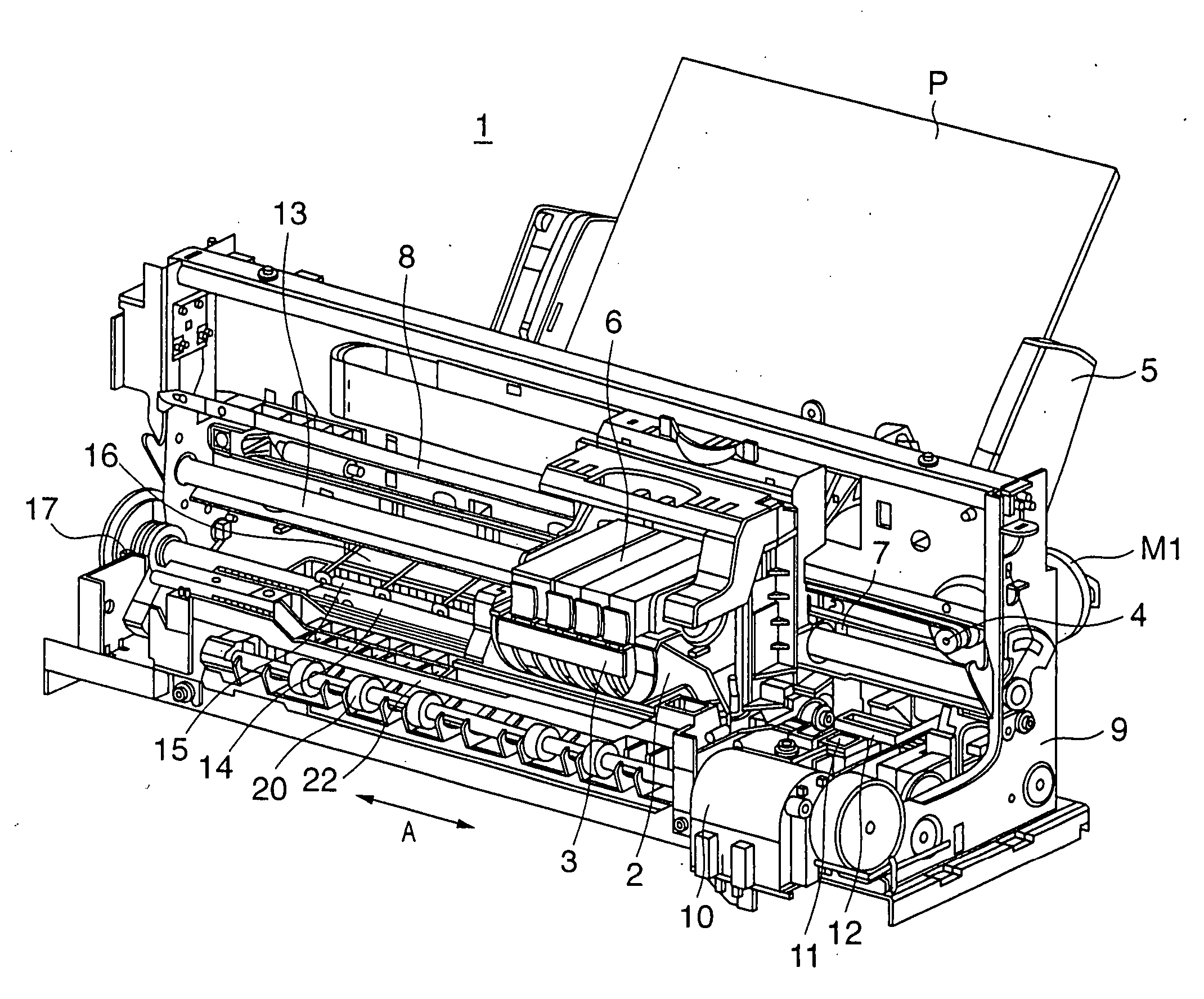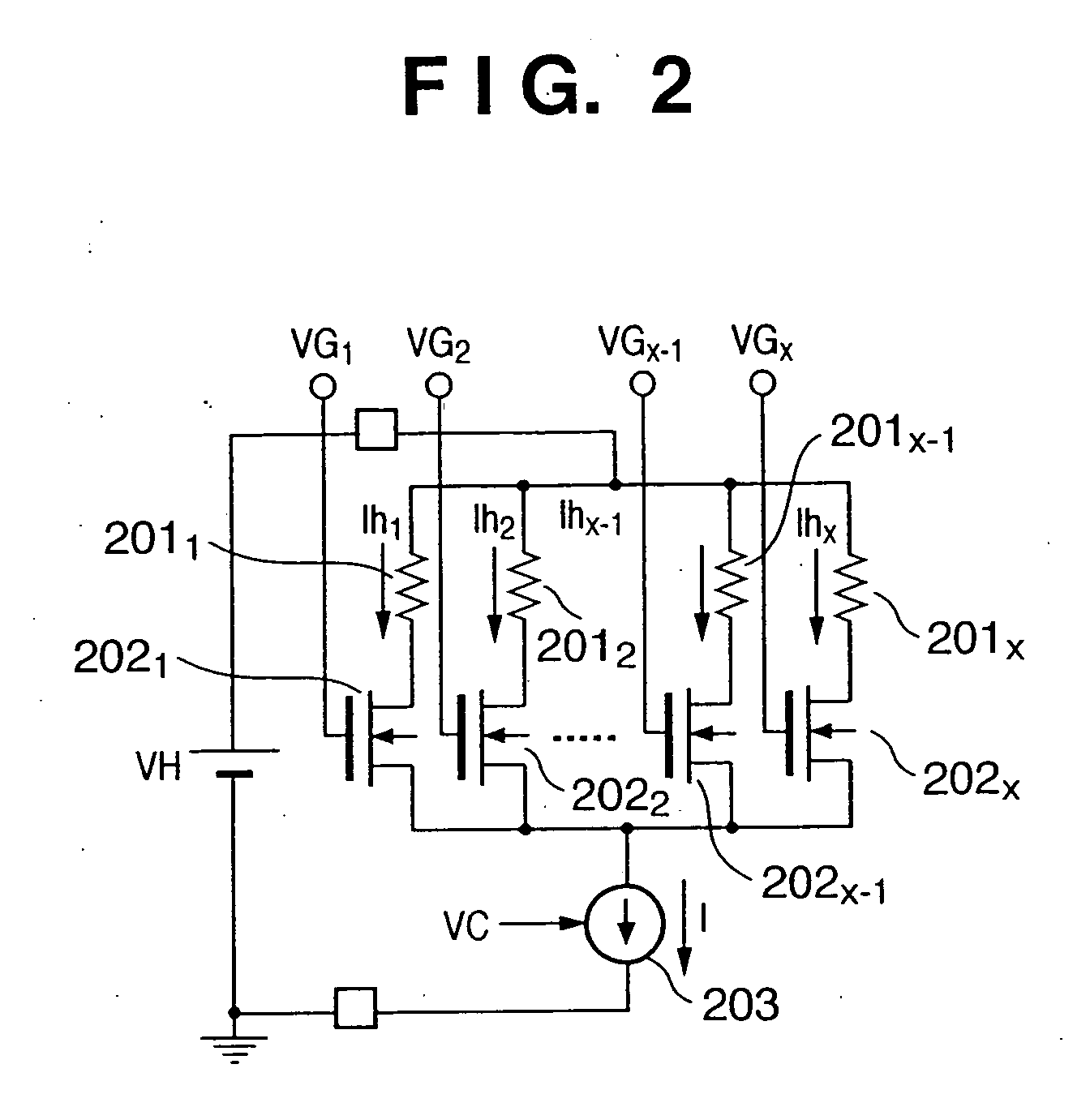Recording head and recorder comprising such recording head
a recording head and recording head technology, applied in the field of recording heads, can solve the problems of limited current value which can be supplied at once, limited electrical power supply capacity of the electric power supply of the printer apparatus, and increase of wiring resistance and resistance variations, and achieve the effect of stably recording
- Summary
- Abstract
- Description
- Claims
- Application Information
AI Technical Summary
Benefits of technology
Problems solved by technology
Method used
Image
Examples
first embodiment
[0041]FIG. 1 is a circuit diagram for explaining the arrangement of a heater driving circuit mounted on the heater substrate of an inkjet printhead according to the first embodiment of the present invention.
[0042] In FIG. 1, reference numerals 10111 to 101mx denote heaters (heater resistors) for printing. A current flows to each heater to generate heat, and a corresponding nozzle discharges an ink droplet. The heaters 10111 to 101mx are divided into blocks (groups) 1 to m, and each block includes x heaters, and x NMOS transistors which are arranged in correspondence with the respective heaters. Reference numerals 10211 to 102mx denote NMOS transistors for ON / OFF-controlling energization to corresponding heaters. Reference numerals 1031 to 103m denote constant current sources which are arranged for the respective blocks. Reference numeral 104 denotes a control circuit which controls ON / OFF operation of each NMOS transistor 102 in accordance with printing data to be printed. Referenc...
second embodiment
[0056]FIG. 4 is a circuit diagram for explaining the arrangement of a head driving circuit in a printhead according to the second embodiment of the present invention. In the second embodiment, the constant current sources 1031 to 103m in the first embodiment are implemented by NMOS transistors 4011 to 401m.
[0057] The drains of the NMOS transistors 4011 to 401m are respectively connected to the sources of NMOS transistors 10211 to 102nx. The gates of the NMOS transistors 4011 to 401m receive a control signal 110 from a reference current circuit 105, and the drains of the NMOS transistors 4011 to 401m output currents. The output currents are controlled by the gate voltages of the MOS transistors 4011 to 401m that are connected to the reference current circuit 105.
[0058] The operation of the NMOS transistors 4011 to 401m in FIG. 4 will be explained with reference to FIGS. 5 and 6.
[0059]FIG. 5 is a graph showing the general static characteristic of an NMOS transistor used as each of ...
third embodiment
[0062]FIG. 7 is a circuit diagram for explaining a head driving circuit in a printhead according to the third embodiment of the present invention. In the third embodiment, the sources of NMOS transistors 7011 to 701m are connected to the drains of the NMOS transistors 4011 to 401m in FIG. 4, and two corresponding NMOS transistors are cascade-connected in series to form a constant current source. The gates of the NMOS transistors 7011 to 701m are also connected to a reference current circuit 105a. The third embodiment will explain a structure of two transistors, but the present invention can also be applied to a structure of a larger number of transistors.
[0063] The NMOS transistors 7011 to 701m operate as grounded-gate transistors, and fix the drain voltages of the NMOS transistors 4011 to 401m on the basis of the potentials between the gates and sources of the NMOS transistors 7011 to 701m. The gate voltages of the NMOS transistors 7011 to 701m are so set as to operate the NMOS tr...
PUM
 Login to View More
Login to View More Abstract
Description
Claims
Application Information
 Login to View More
Login to View More - R&D
- Intellectual Property
- Life Sciences
- Materials
- Tech Scout
- Unparalleled Data Quality
- Higher Quality Content
- 60% Fewer Hallucinations
Browse by: Latest US Patents, China's latest patents, Technical Efficacy Thesaurus, Application Domain, Technology Topic, Popular Technical Reports.
© 2025 PatSnap. All rights reserved.Legal|Privacy policy|Modern Slavery Act Transparency Statement|Sitemap|About US| Contact US: help@patsnap.com



